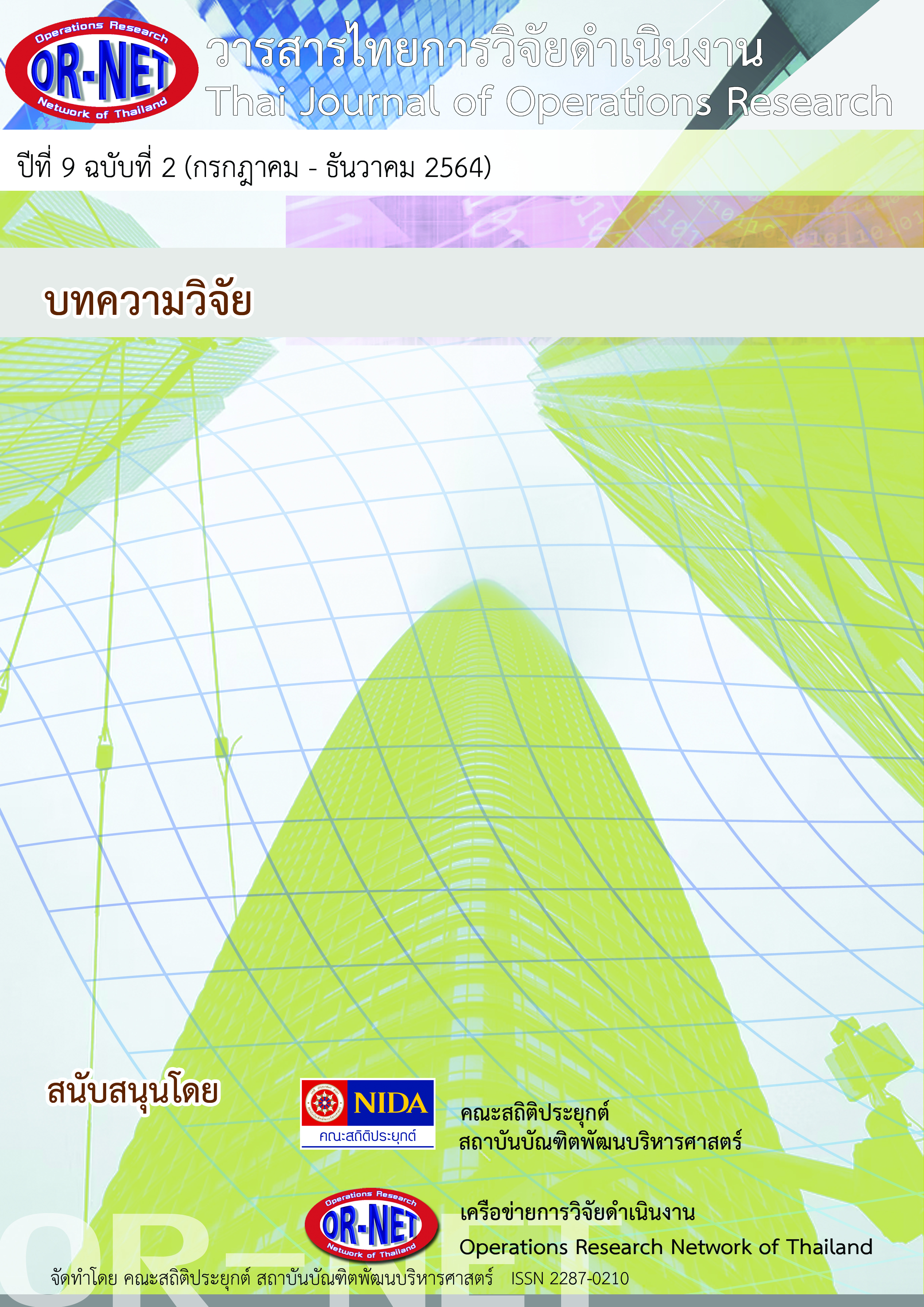Use of Association Rules Bases Storage Assignment Location for Improving Class-Based Warehouse Design: Case Study A Packaging Company
Keywords:
Storage Location Assignment, Association Rules, warehouse efficiency improvement, case studyAbstract
The objective of this research is to improve the efficiency of a warehouse of a packaging company by re-assignment of storage location. As observed the company’s exiting problems, there is an issue on the inappropriate storage locations, causing problems of unnecessary travel distances and delays shipping as well as additional costs of overtime. To overcome this, the study formulated the problem as storage location re-assignment problems. The revised product placements and locations are applied a concept of association rules to find the relationships between items that be frequently ordered together and make them as the new product family, ranging from high-, medium-, and low movements. The proposed linear programming problem is solved by Fast-Mover-Closet-to-Door concepts with Open Solver in Microsoft Excel as the solver tool to find the optimal solution. The result shows that the new product location and layout can significantly help improving the warehouse efficiency in terms of decreasing picking distances by 30.40%, reducing the period of overtime hiring by 90.76% and reducing overtime costs by 50,982 baht a year approximately. Furthermore, it can improve the labor productivity of normal picking times up to 6.82%.
References
[2] อชิระ เมธารัชตกุล. 2557. การเพิ่มประสิทธิภาพการจัดการคลังสินค้า: กรณีศึกษา บริษัทผลิตชิ้นส่วนรถยนต์. งานนิพนธ์วิทยาศาสตรมหาบัณฑิต มหาวิทยาลัยบูรพา.
[3] อรวรรณ มัชฌิมาจิต และคณะ. 2552. การปรับปรุงการจัดเก็บสินค้าคงคลังผลิตภัณฑ์น้ำผลไม้บรรจุขวดโดยใช้ชั้นวางสินค้าและการจัดเก็บสินค้าตามปริมาณความต้องการพื้นฐาน. ใน การประชุมสัมมนาวิชาการด้านการจัดการโลจิสติกส์และโซ่อุปทาน ครั้งที่ 9 (ThaiVCML2009). 19-21 พฤศจิกายน 2552. มหาวิทยาลัยบูรพา: คณะอุตสาหกรรมเกษตร มหาวิทยาลัยสงขลานครินทร์.
[4] ศิริวัฒน์ รุ่งมณีรัตน์. 2555. การปรับปรุงประสิทธิภาพการจัดการคลังสินค้า: กรณีศึกษาโรงงานผลิตผงอุตสาหกรรม. ปริญญานิพนธ์วิศวกรรมศาสตรมหาบัณฑิต มหาวิทยาลัยศรีนครินทรวิโรฒ.
[5] วิทยา คาระคำ. 2559. แนวทางการออกแบบผังการจัดเก็บสินค้าสำหรับคลังสินค้า บริษัท ABC จำกัด. งานนิพนธ์บริหารธุรกิจมหาบัณฑิต มหาวิทยาลัยบูรพา.
[6] สมคิด พาละแพน และจุฑา พิชิตลำเค็ญ. 2555. การปรับปรุงผังการจัดเก็บสินค้าเพื่อเพิ่มประสิทธิภาพการดำเนินงานในกระบวนการรับและจ่ายสินค้า: กรณีศึกษาคลังจัดเก็บผลิตภัณฑ์นมสำเร็จรูป. ใน การประชุมวิชาการข่ายงานวิศวกรรมอุตสาหการ ประจำปี พ.ศ. 2555, 17-19 ตุลาคม 2555. เพชรบุรี: คณะวิศวกรรมศาสตร์ มหาวิทยาลัยเกษตรศาสตร์.
[7] ณัฐวดี ปัญญาพานิช. 2556. การประยุกต์ใช้แบบจำลองสถานการณ์ในการวิเคราะห์ประสิทธิภาพกระบวนการหยิบสินค้า. วิทยานิพนธ์วิทยาศาสตรมหาบัณฑิต จุฬาลงกรณ์มหาวิทยาลัย.
[8] นันทวุฒิ คะอังกุ. 2555. วิธีแบ่งช่วงข้อมูลสำหรับการหาความสัมพันธ์. วิทยานิพนธ์วิศวกรรมศาสตรบัณฑิต มหาวิทยาลัยเทคโนสุรนารี
[9] วิวัฒน์ ชินนาทศิริกุล. การทำเหมืองข้อมูล ตอน การหาความสัมพันธ์ของข้อมูลด้วย Apriori algorithm. สาขาวิทยาการคอมพิวเตอร์ คณะวิทยาศาสตร์และเทคโนโลยี มหาวิทยาลัยราชภัฏวไลยอลงกรณ์ ในพระบรมราชูปถัมภ์.
[10] ทองพูล หีบไธสง. 2561. การทำเหมืองข้อมูลด้วยโปรแกรม Orange. คณะเทคโนโลยีสารสนเทศ มหาวิทยาลัยเทคโนโลยีพระจอมเกล้าพระนครเหนือ.
[11] ไชยพร ปรีชาวงศ์. 2556. การเพิ่มประสิทธิภาพคลังสินค้าอัติโนมัติด้วยการจัดแบ่งพื้นที่จัดเก็บสินค้า. งานนิพนธ์วิทยาศาสตรมหาบัณฑิต มหาวิทยาลัยบูรพา.
[12] โสภณ สุขสวัสดิ์. 2557. การปรับปรุงประสิทธิภาพตำแหน่งการจัดวางสินค้าในคลังสินค้า: กรณีศึกษาบริษัทผลิตยางผสม (RUBBER COMPOUND). วิทยาศาสตรมหาบัณฑิต มหาวิทยาลัยบูรพา.
[13] Yi-Fei Chuang, Hsu-Tung Lee and Yi-Chuan Lai. 2012. Item-associated cluster assignment model on storage allocation problems. Computers & Industrial Engineering 63: 1171-1177. www.elsevier.com/locate/caie




